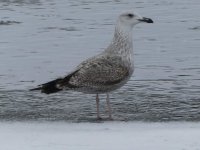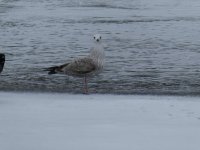I hoped for comments, but as no one has answered yet, I make a start (no definite answer):
its an 2 cy Herring-Gull- type for me.
First impression (including shape with "normal" bill and short legs) is good for a Herring Gull, I think it wouldnt stand out in a Herring Gull flock .
But knowing it was seen in Lithuania, its good to check it for cachinnans-features:
-extensive dark tertials with worn off, but right looking pale edges (hard to judge due to wear).
- washed smooth fine barring to greater coverts gradually merging into a uniform smooth dark area, like a diluted water-colour painting.
-if you are looking hard enough (it isnt easy, but you can do this, just trust in your Jedi-skills), you can imagine, that the 100% ID-book Herring Gull-barring to upperpart-feathers is shifted slightly towards a cachinnans-pattern.
All this is sure within variation for a Herring Gull, but I think this bird highlights the problem well:
with such an extensive introgression/hybridisation in Herring, Caspian and other Gull-species, a large gull is often, what the experts say it is. They define the phenotypical boundaries for one species here.
This definition, what, for example an acceptable Caspian Gull looks like, and a definition of acceptable limits in variation, is one thing, that I hope the new Gull-ID-Guide provides, actually an update of previous work in this case (so maybe work in progress?).





